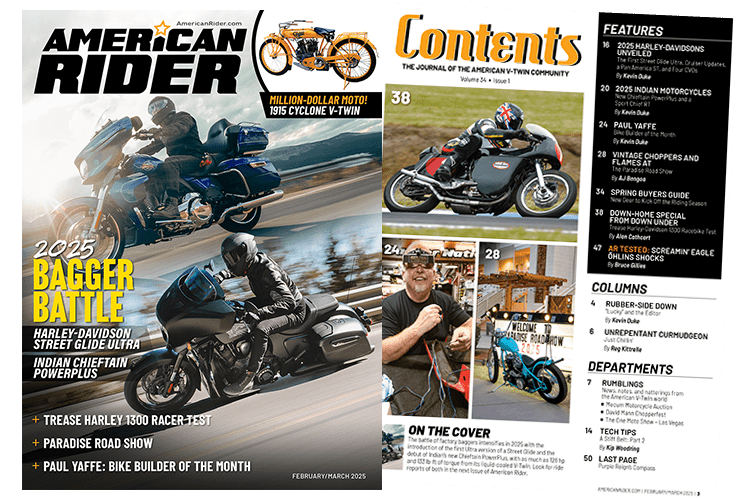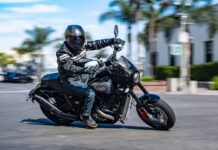Daytona Beach, Fla.—Just like the new girl from out of town that shows up unexpected at the high school dance, Victory Motorcycles’ recent unveiling of the 2017 Octane introduced a new and exciting gal to the prom. But this new model was not a total surprise since several one-off teaser versions based on the same platform foreshadowed the Octane’s release. In 2015 at the EICMA Show in Milan a concept bike built by Urs Erbacher from Switzerland was presented utilizing a production-intended engine rumored to power a new model of Victory. A second concept bike using the same engine and tagged Combustion was constructed by Zach Ness and on stage at the IMS in New York City in December of last year. But before either of those custom rides were on display, Victory Motorcycles, in an attempt to promote its product as the “Modern American Muscle Brand,” envisioned Project 156, the earliest “Octane” prototype that was given the challenge of tackling the 2015 Pikes Peak Hill Climb competition (there are 156 turns on the 12-1/2 mile mountain course). Noted racer and designer Roland Sands spearheaded Project 156 providing the Octane with great street cred before it was ever launched, a brilliant marketing ploy. So no, the unveiling in Daytona was not a total surprise—but the end product certainly was.

Out with the old
I first became acquainted with Victory during a three-day ride from Utah to the Black Hills Classic during the company’s media launch of their new Cross Country Tour model in 2011. The bike featured the admirable Freedom 106 engine, a powerplant that has been standard issue on every model since it was upgraded from 100 cubic inches in 2008 and earning the reputation for being bulletproof in the interim. But the release of the 2017 Octane engine constitutes the most radical departure from the Freedom design possible. Liquid-cooled, 1200cc 60-degree layout with double overhead cams, a whopping 10.8:1 compression ratio and 4 valves per cylinder work in unison to deliver 104 hp at 8000 rpm and 76 ft/lbs at 6000 rpm and make the Octane engine the most powerful in the entire Victory lineup. And while those horsepower and torque values are impressive enough, when coupled with a final dry weight of only 525 lbs. (the Victory Gunner weighs in at 649 dry), the weight-to-horsepower ratio can be felt on every level across the entire power band. To fully appreciate the bike’s capabilities, I took the Octane out on Interstate 95 between Daytona and Ormond Beach for a high-speed run and was quite surprised. At 60 mph, cruising in 6th gear I pegged the throttle. Without downshifting, the bike hit the ton mark in less than four seconds. I was impressed.

major class
Some have accused the Octane engine as being derived from the Indian Scout (Polaris is the parent company of both Indian Motorcycle and Victory). And while there are similarities, I couldn’t imagine such sharing of engineering until I learned that Polaris is open about the fact that the Octane shares up to 35 percent of its parts with the Indian Scout. But while that may be true, the Octane not only delivers more power to the rear wheel but is lighter and years ahead of the Scout in aesthetics. (Plus it costs a grand less.)


The Octane’s frame is cast aluminum with no sub-carriage under the motor with the engine serving as a stressed member. Tires are a 130/70-18” up front with a 160/70-17” following, each with 10-spoke cast wheels, providing flawless handling. (Lean angle is 32 degrees.) A single-piston brake in the rear with a dual-piston, single-disc front brake seem more than adequate due to the bike’s svelte weight. Both front and rear brakes are conventional, not ABS. The forward controls are positioned excellently for a wide range of riders, my 6-foot frame fitting perfectly with the pegs and controls locations. But while the shifter peg and rear brake pedal are ideally located, they both could stand to be at least ½” longer. Rear suspension duties are handled by dual-rate springs with an adjustable preload and 3” of travel. The hydraulic front forks also utilize dual-rate springs and provide 4.7” of bounce.
Subdued elegance
The transmission is a silky-smooth 6-speed with a belt final drive. The instrument panel is simple and includes an odometer, tripmeter and engine temperature gauge all selected by a finger toggle on the clutch perch. (Interestingly the speedo has a 200 mph reading.) This single instrument package is nestled behind a mini tinted windscreen that melds into a nacelle that houses the headlamp. The 3.4-gallon fuel tank has ribbed accents across the top, knee scallops formed into each side and uses an aircraft-style locking gas cap. The unique seat dovetails into the rear of the gas tank and is covered with a top layer that must be the most non-skid material in the industry—you plant your butt and you’re not going anywhere, which is a good thing since the power on tap would have you fighting to stay in the saddle with a standard covering. A modest lumbar support provides an extra touch of comfort and security. The front frame downtubes are a massive chunk of cast aluminum that effectively encases the radiator, successfully disguising the water unit behind a batmobile-stylized finned cowling. Watching the instrument panel’s temperature indicator, the water-cooling range varied from 160 to 210 degrees F. Not surprisingly, the 2017 Octane comes in only a single paint scheme, Matte Super Steel Gray.


As much as I’ve enjoyed earlier Victory models, this product steps upon a new stage. An impressive departure from the norm, between the bike’s horsepower and lightweight handling capabilities, the 2017 Octane may truly be the most fun Victory to date. And with a MSRP of only $10,499 and staking claim to the title of “Modern American Muscle Brand,” the Octane kicks open doors, enticing a generation of young, performance-minded riders—just the clientele every American motorcycle manufacturer is desperately seeking.



two-up accessory kit with buddy seat, backrest for driver and passenger and a luggage
rack has already been developed


















—(Plus it costs a grand less.)—
a grand less than what?